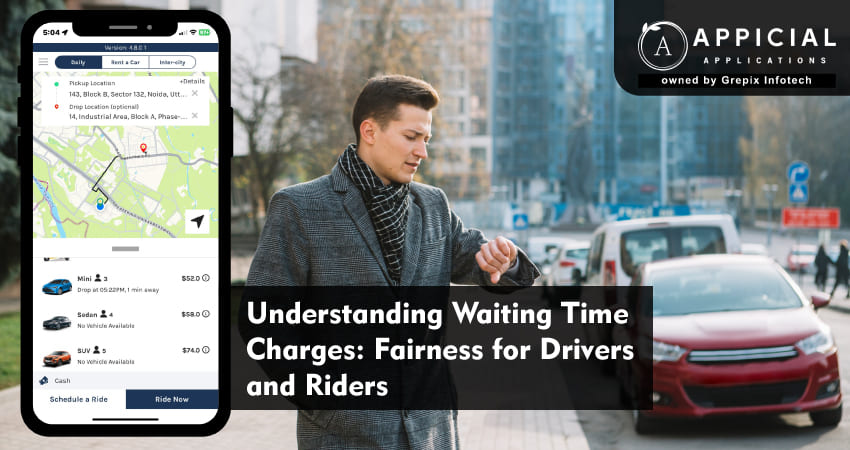
Understanding Waiting Time Charges: Fairness for Drivers and Riders in Ride-Hailing Apps
In the fast-evolving mobility industry, wait time charges have become a critical component of fare structures in modern ride-hailing and ride-sharing apps. As platforms scale and competition intensifies, the challenge is to balance the economics and fairness for both riders and drivers. A key feature of a robust Uber Clone or white-label taxi booking app is how it manages waiting time when a driver waits for a passenger or when a passenger delays departure.
This blog examines why waiting time charges matter, how they should be structured, their fairness implications, and how your taxi app development company or white-label taxi app development company can integrate them into your platform architecture.
This article explores how wait-time charges work in a modern ride-hailing app framework. It examines the rationale for charging for waiting time, the fairness implications for drivers and riders, operational and technical considerations, market data on wait times in ride-hailing services, and best practices for implementing robust waiting-time charge modules. It also shows how a taxi app development company, or a white-label taxi app development company, can build this feature into a ride-sharing app or an Uber Clone. The conclusion highlights how Appicial Applications can help you develop a full-featured e-hailing app with built-in waiting time logic, and invites you to connect.
Why Are Waiting Time Charges Necessary?
From a Driver’s Perspective
Drivers invest time, fuel, and opportunity cost while waiting instead of earning another trip. In a ride-hailing app, if a driver arrives at the pickup location and the passenger delays boarding, the driver is essentially idle. Without waiting time charges, the platform subsidises this idleness. Over many trips, this erodes driver satisfaction and fairness. Ensuring that waiting time is remunerated gives drivers confidence in the platform's economics. In ride-sharing or e-hailing apps, drivers need predictable earnings and fair treatment to remain loyal.
From a Rider’s Perspective
For riders, delays are inherently undesirable. They expect prompt arrival and quick turnover. However, if waiting time charges are opaque or excessive, riders may feel unfairly penalised. In a well-designed Uber Clone or white label taxi booking app, the waiting time rules are clearly defined, communicated, and justified. The transparency cultivates trust and perceived fairness. Without this clarity, riders may abandon the platform or complain, which can damage its reputation.
From the Platform’s Perspective
The platform acts as a mediator. It needs to reconcile driver supply, rider demand, and time efficiency. Waiting time charges help the platform allocate resources efficiently. They discourage excessive waiting by riders and ensure drivers who wait are compensated. For a taxi app development company building the system, waiting time modules are essential for full monetisation. They help manage driver idle time, boost utilisation, and make the business model sustainable for the white label taxi app development company delivering the build.
Aligning Incentives and Fairness
In the mobility ecosystem, fairness is increasingly scrutinised. Drivers must feel they are treated equitably and riders must feel they are not unfairly charged. Waiting time charges serve as an alignment tool. When riders delay, they bear the cost; when drivers wait, they are rewarded. A ride-hailing app or e-hailing app that neglects this becomes susceptible to dissatisfaction on both sides, which may lead to driver churn and rider drop-off.
What Do Market Data and Studies Reveal?
Waiting Time and Ride Hailing Service Quality
Studies indicate that ride-hailing services tend to outperform traditional taxis in terms of wait-time reliability. For instance, in one audit study in Los Angeles, ride-hail wait times were much shorter: about half of ride-hail trips had wait times under 5 minutes, compared to much more variable waits for taxis. This implies that waiting time is a measurable and meaningful service attribute. From this, it follows that waiting time charges should also reflect the value of driver time and the cost of delay.
Another dataset shows a “left-skewed” distribution of ride-hail wait times, with about 50% under 5 minutes and ~42% between 5 and 10 minutes. Short waits matter to riders, and delayed drivers translate to cost. Understanding this helps your white-label taxi booking app design implement churn-minimising waiting fee logic.
The Value of Time and Waiting
A research paper on ride-hail pricing found that consumers’ willingness to pay for reduced wait times is significant. This translates into an operational lever: if waiting time is un-priced, the platform loses potential value and may mis-align driver-rider incentives. For your Uber Clone, embedding waiting time charges can capture part of this incremental value and distribute it fairly.
Supply-Demand Imbalance and Waiting Costs
When driver supply is thin relative to demand, wait times lengthen and cancellation risk increases. A study on pricing optimisation in ride-hailing noted that when surge pricing or waiting is mis-handled, both driver en-route time and rider waiting time rise significantly. The waiting time charge is one lever to manage costs, discourage unnecessary lag, and promote responsiveness. A top-tier taxi app development company will build monitoring and dynamic waiting billing modules accordingly.
What Constitutes Fair Waiting Time Charges?
Clear Definition of “Waiting Time”
The first step for any ride-sharing app or ride-hailing app is to define waiting time: when it starts, when it ends, and how it is triggered. Waiting time might begin when the driver arrives at the pickup point and the rider has not boarded within a certain free-buffer period. The white label taxi booking app must reflect this logic and communicate it in the UI: e.g., “Free waiting for 2 minutes, after that ₹ 10 per minute”. The taxi app development company must ensure that both driver and rider apps show the countdown transparently.
Free Buffer Periods
Many platforms offer a free waiting buffer, typically 1-3 minutes, so riders are not penalised for minor delays. After this buffer, the waiting charge kicks in. This free buffer helps avoid perception of unfairness. A proper Uber Clone should support configurable buffer logic (by city and vehicle class) so the platform can adapt across markets.
Charging Mechanism (Per Minute or Flat)
Waiting time charges may be flat (e.g., a fixed fee after the buffer) or per-minute (e.g., $ 5/min). The charging mechanism should reflect the driver's value of time, the local operating costs, and the rider's tolerance. It’s important to benchmark the thresholds to ensure rider acceptance and avoid backlash. In your e-hailing app, the waiting charge must be justified by supply cost and clearly explained to the user.
Visibility and Consent
Transparency is key. The fare breakdown shown to riders should list the waiting time charge separately so they understand why the total is higher. A white-label taxi app development company should build UI modules for fare breakdowns that include a separate line item for waiting time. Visibility fosters fairness.
Proportionality and Reasonableness
Charges must be proportionate; excessively high waiting fees feel exploitative. For instance, if the waiting fee is higher than the cost of a second ride, riders will complain. A well-designed taxi app development company will recommend sliding scales or ceilings. Reasonable waiting fees protect both the platform’s reputation and user retention.
Driver Compensation vs Platform Commission
On the driver side, waiting time charges should flow through correctly: the driver must receive a share of, or the full value of, the waiting charges. This ensures that the burden of boarding delays does not fall unfairly on drivers. A solid ride-sharing app architecture built by your taxi app development company must manage revenue splits, including waiting time fees.
What Are the Major Challenges and Fairness Considerations?
Avoiding Double Charging or Hidden Fees
If a rider has already paid a pickup fee or waited long in traffic (outside their control), adding waiting time charges feels unfair. The platform must clearly distinguish driver waiting vs systemic delays. A hasty rolling out of charges in a ride-hailing app without contextual fairness may drive away users. A white-label taxi booking app must include logic to account for external delays or provide reimbursement mechanisms.
Monitoring and Dispute Handling
Drivers and riders will dispute waiting times, especially if delays are ambiguous (who arrived first, who flagged the wait?). The platform should have a transparent dispute mechanism. In your Uber Clone, the taxi app development company must build logs (timestamp driver arrival, rider boarding time) and a support system to handle complaints.
Variation by Market and Vehicle Class
Different regions have different norms for waiting time. Luxury vehicles might tolerate longer waits than economy class. In a ride-sharing app, you may charge more for premium classes. Your white-label taxi app development company should provide configurable waiting-time parameters by vehicle class and region.
Impact on Rider Behaviour
Waiting fees may discourage riders from making legitimate trips if they fear penalties for being late. This becomes a fairness issue: delays due to elevator faults, traffic jams or pickups from large venues may lead to high waiting charges. The ride-hailing app must mitigate this by generous buffers or compensations for external delays. A fair system encourages trust, which is critical.
Driver Acceptance and Matching Efficiency
From the driver's side, waiting time charges should not be the only incentive. If drivers routinely find themselves waiting and bearing risk, they may decline low-margin pickups or prioritise riders who board quickly. This harms supply. Your taxi app development company must design the matching algorithm so that waiting time is balanced with driver routing, pickups, and average trip length to avoid systemic inefficiency.
How to Implement Waiting Time Charges in Your App?
Modular Architecture and Configurability
If you are building an Uber Clone or white label taxi booking app, your architecture should treat waiting time logic as a configurable module: free buffer minutes, per-minute charges, per vehicle class, exclusions for specific zones (airport pickup, events). A professional white label taxi app development company will build an admin console to adjust parameters by city, vehicle type, and time of day.
Driver App and Rider App Synchronisation
Both the rider and driver must have consistent information. The driver app should show when waiting time begins, at what rate, and escalate visually. The rider app should show a countdown, the expected additional charge, and an opportunity to cancel or proceed. A proper ride-sharing app design ensures both sides see the same timestamps, and the system logs timestamps for audit.
Real-Time Timestamp Logging and Transparency
Accurate logging is essential: driver arrival time, rider boarding time, and delay reason if applicable. This enables the ride-hailing app to defend waiting time charges and resolve disputes. The taxi app development company should implement backend logs and dashboards for monitoring average waiting minutes, dispute rates, and the frequency of waiting fees.
Fare Breakdown on Receipt and In-App
After trip completion, the waiting time charge should appear as a discrete line item in the invoice/receipt. This promotes transparency and reassures riders. The design of your e-hailing app or white label taxi booking app must ensure invoice readability and breakdown.
Also Read: How Fare Estimation Improves Transparency in Ride-Hailing Apps
Analytics, Reporting and Driver-Rider Feedback
Monitor average waiting minutes per driver, per zone, per hour. If a driver experiences high waiting minutes regularly, the platform may intervene (e.g., adjust driver zone or rider assignment). If riders experience frequent waits leading to charges, the platform may adjust the free buffer or re-evaluate the driver supply. A taxi app development company should provide dashboards for waiting time analytics and KPIs.
Communication and Education
When you launch waiting time charges, communicate to both riders and drivers clearly. Use tool-tips, FAQs, and in-app notifications. For your Uber Clone rollout, your taxi app development company should support educational material, sample UI flows, and notifications explaining “Why am I being charged for waiting time?” Clear messaging improves acceptance.
Why Choose Appicial Applications to Build Your Waiting Time Module?
When you decide to build an advanced ride-hailing app, ride-sharing app, or e-hailing app that includes fair waiting time charge logic, you want a partner who understands mobility, platform economics, UX standards, and backend architecture. Appicial Applications brings you that depth of capability.
- They specialise in delivering full-fledged Uber Clone solutions and white label taxi booking app platforms.
- As a trusted taxi app development company, they build modular features such as waiting time charge logic, fare breakdown, dispute modules, driver-rider dashboards, and analytics.
- As a capable white-label taxi app development company, they let you launch quickly with full codebase ownership, rebranding capabilities, and region-specific configuration (waiting buffers, per-minute rates, vehicle classes, zones).
- Their architecture supports seamless integration of waiting time charges in the dispatch flow, fare computation module, driver-rider apps, admin console, and analytics backend.
- They emphasise fairness and transparency: waiting charge breakdown, rider and driver visibility, logs and timestamps built in, dispute workflows.
- Post-launch, Appicial Applications supports monitoring, KPI tracking, data-driven tuning of waiting time parameters, and marketing roll-out of the feature to drive adoption.
If you are ready to build or upgrade your mobility platform with robust waiting time charge modules, turn-key ride-hailing app features, and fast go-to-market with an Uber Clone / white label taxi booking app, contact Appicial Applications today.
Let them guide you through a free consultation, demo the waiting charge module, and deliver a scalable, fair, efficient e-hailing app built for both drivers and riders.
Conclusion
Waiting time charges are no longer an optional add-on in modern mobility platforms; they are a core element of fare structure, driver economics, rider fairness, and platform sustainability. For your ride-sharing app, ride-hailing app, or e-hailing app, implementing waiting time logic means you acknowledge driver time, align incentives, enhance service reliability, and offer transparent pricing to riders.
Managers and founders behind an Uber Clone or a white-label taxi booking app must ensure that waiting-time policies are clearly defined, fairly applied, configurable by market, visible in the user interface, and supported by robust logging and dispute workflows. A high-quality taxi app development company or white label taxi app development company is essential to build this functionality correctly.
With Appicial Applications as your development partner, you access domain expertise, modular architecture, configurable waiting time mechanics, and a clear go-to-market plan. Whether you are launching in Delhi, Bangalore, or internationally, you can trust them to implement waiting time charges that balance fairness, drive revenue, and promote driver-rider trust.
Take the next step. Build your mobility platform on the foundations of fairness and transparency. Contact Appicial Applications today, and integrate waiting time charges the right way in your ride-hailing ecosystem.
FAQs
Author's Bio

Vinay Jain is the Founder at Grepix Infotech and brings over 12 years of entrepreneurial experience. His focus revolves around software & business development and customer satisfaction.
Back to blog list




